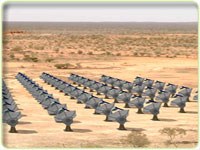Square Kilometre Array (SKA) Station
Return to WA in Space
The proposed SKA site has been relocated westwards to Boolardy Station from the original choice of Mileura Station to ensure separation from the radio-frequency (RF) interference of planned mining activities in the region. It SKA station will be known as the Australian Square Kilometre Array Pathfinder (ASKAP).
The State Government will work with the Commonwealth to develop legislation to protect the ASKAP site from unacceptable levels of RF interference.
For more detailed information see:
http://www.sciencewa.net.au/science_news.asp?pg=21&NID=1025 http://www.sciencewa.net.au:80/science_news.asp?pg=21&NID=1107
and the Australian canditate site: http://www.atnf.csiro.au/projects/ska/mileura.html
!! NEWS FLASH !!
Giant array starts to take shape
Almost a quarter of a century after it was first conceived, the international Square Kilometre Array (SKA) radio-telescope project is finally moving towards physical reality. Planned to consist of a linked array of up to 3000 separate receivers spread over 3000 km, SKA will be some 50 times more sensitive than the most powerful radio telescopes of today. Now, the first significant funding for the project has been obtained, and an intense competition to host the array is currently under way.
Involving researchers from 55 institutes in 19 different nations, SKA will have the same collecting area as a single telescope 1000m in diameter. With high-speed data transfer from each antenna to the computing core and signals processed by supercomputers, SKA will be able to look back to the first 100 million years after the Big Bang to study the evolution of galaxies, search for dark matter and energy, and probe the so-called dark ages - the period about 300 000 years after the Big Bang when the universe was cool enough for electrons and protons to bind together.
[snip]
In 2006 the location of the giant array was narrowed by the SKA consortium to the Karoo region in northern South Africa or to Murchison in Western Australia. South Africa would place outlying antennas on a north-south axis in five other African countries (Botswana, Namibia, Mozambique, Kenya and Ghana) along with Madagascar and Mauritius. Australia offers an east-west axis and could expand its baseline to 6000 km by adding links to New Zealand.
South Africa and Australia have strong political and financial support for SKA, with each country having pledged about €85m (Rand 1bn and A$145m, respectively). This money will be spent on preparing bids to house SKA, including testing the sites for radio quietness. Two novel "SKA pathfinder" telescopes will be built to evaluate the new technology for the project and the merits of the sites. Australia's pilot 12 m dish will test an ambitious phased array that can receive 100 signals simultaneously and will eventually include up to 45 dishes at Murchison. While South Africa's 12m dish will receive only a single signal, the array will then be expanded to 50 units at Karoo. But even if SKA is delayed, the pilot projects in South Africa and Australia will be the two most powerful radio telescopes for studying the southern sky. A decision on where SKA will be built is due in 2011; the facility could be ready by 2020.
Peter Pockley, Sydney
'PhysicsWorld (Journal of the Institute of Physics), Vol 21 No 6 p.7, June 2008
Return to WA in Space



